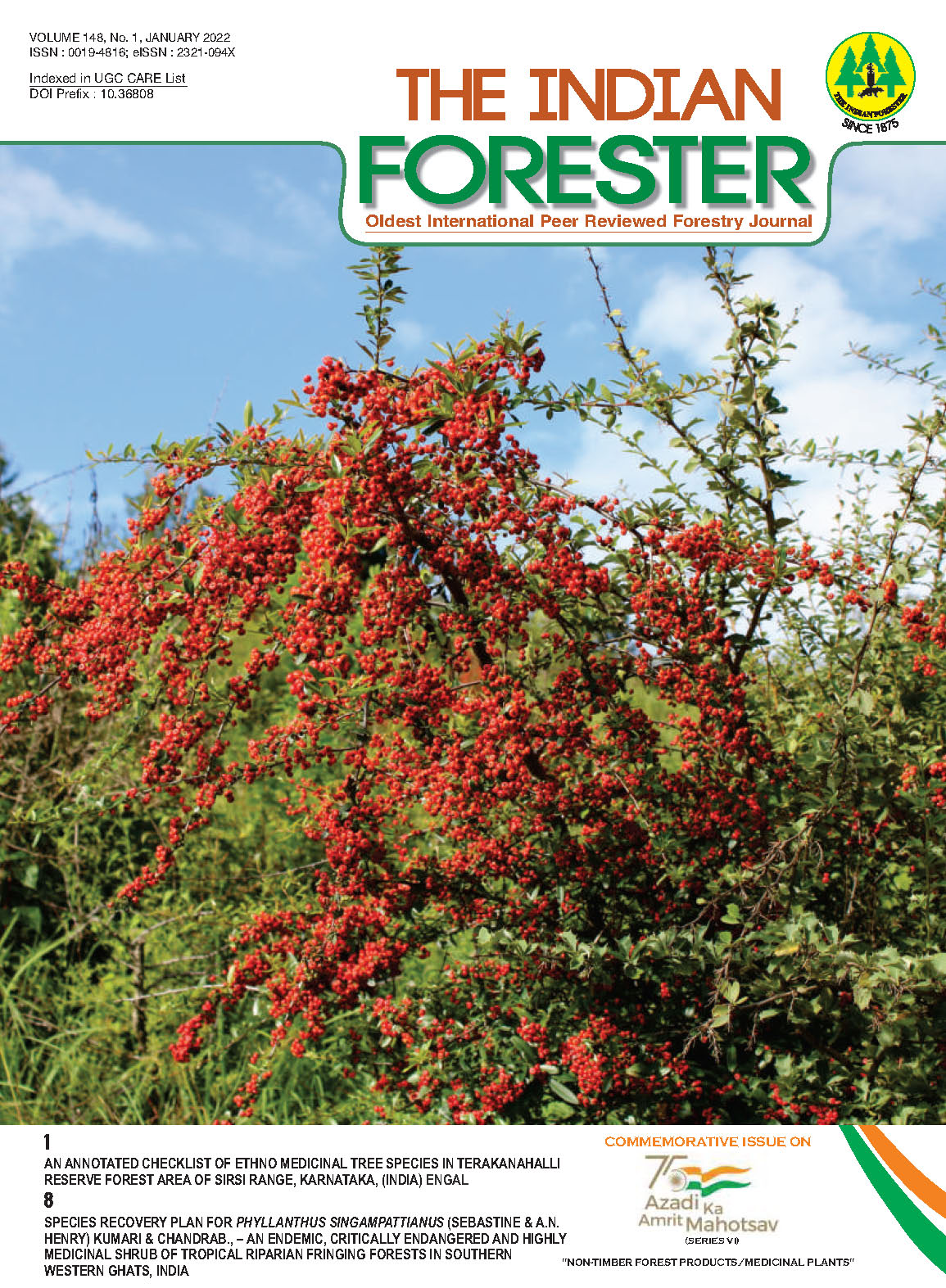Ethnomedicinal Uses of Fraxinus xanthoxyloides (Afghan Ash): A Review
DOI:
https://doi.org/10.36808/if/2022/v148i1/160610Keywords:
Afghan ash, Fodder, Population status, Genetic variation, Habitat destructionAbstract
No Abstract.
References
Anon (1956). The Wealth of India, Raw Materials, Vol, IV: F-G. Publication and Information Directorate, (CSIR), New Delhi pp. 61-63.
Arca M., Hinsinger D.D., Cruaud C., Tillier A., Bousquet J. and Frascaria-Lacoste N. (2012). Deciduous trees and the application of universal DNA barcodes: A case study on the circumpolar Fraxinus. PLoS One, 7(3): e34089.
Barstow M., Oldfield S., Westwood M., Jerome D., Beech E. and Rivers M. (2018). The red list of Fraxinus. Botanic Gardens Conservation International.
Calis I., Hosny M., Khalifa T. and Nishibe S. (1993). Secoiridoids from Fraxinus angusti- folia. Phytochemistry, 33: 1453-1456.
Chang Mei-Chen, Miao, Bo-Mao, Lu, Rui-Ling. and Qiu, LianQing, (1992). Oleaceae. In: Chang, M.-C., Qiu, L.-Q. (Eds.), Fl. Reipubl. Popularis Sin, 61, pp. 1–222.
Duan J.J., Bauer L.S., Van Driesche R.G. and Gould J.R. (2018). Progress and challenges of protecting North American ash trees from the emerald ash borer using biological control. Forests, 9(3): 142.
Iftikhar M., Riaz N., Saleem M., Musaddiq S., Jabbar A. and Tareen R.B. (2015). Xanthoxyloidin, a New Biscoumarin from Fraxinus xanthoxyloides. J. Chemi Soci Pak., 37(3).
Kumar A., Mitra M., Adhikari B.S. and Rawat G.S. (2016). Flora of Niti valley: a cold arid region of Nanda Devi Biosphere Reserve, Western Himalaya, India. Check list, 12(1): 1824.
Lee H.S., Park S.H., Wallander E. and Chang C.S. (2012). A flavonoid survey of Fraxinus (Oleaceae) in eastern Asia, and the overlooked species Fraxinus hopeiensis T. Tang in Northern China. Biochemical Systematics and Ecology, 41: 150-156.
Lingelsheim A. (1920). Oleaceae-Oleoideae-Fraxineae. In: Engler, A. (Ed.), Das Pflanzenreich IV, vol. 243. Wilhelm Engelmann, Leipzig, pp. 1–61.
Negi P.S. and Sharma S. (2015). Effect of time of fruit collection on the seed germination of Fraxinus xanthoxyloides (Wall. Ex G. Don) DC. Indian Forester, 141(4): 379-383.
Thapliyal M., Namitha N.K., Kumar A., Rathore K. and Dangwal S. (2021). Effect of short-term storage conditions on seed germination of Fraxinus micrantha. Biological Forum-An International Journal. 13(2): 320-324.
Troup R.S. (1921). The silviculture of Indian trees (Vol. 1). Clarendon Press.
Wallander E. (2001). Evolution of wind-pollination in Fraxinus (Oleaceae): an ecophylogenetic approach. PhD thesis, Go¨teborg University, Sweden
Wallander E. (2008). Systematics of Fraxinus (Oleaceae) and evolution of dioecy. Plant Syst Evol., 273: 25–49.
Wei Z. and Green P.S. (1996). Fraxinus. In: Wu, Z., Raven, P.H. (Eds.), Flora of China, vol. 15. Science Press & Missouri Botanical Garden, Beijing and St. Louis, pp. 273–279.
Willis J.C. (1985). A Dictionary of the Flowering Plants and Ferns. Cambridge University Press, Cambridge.
Yamaguchi Y., Meeboon J., Heluta V.P., Liu S.Y., Feng J. and Takamatsu S. (2021). Phylogeny and taxonomy of Erysiphe species (powdery mildew: Erysiphaceae) occurring on the ash trees (Fraxinus spp.). Mycoscience, 62(2): 115-123.
Younis, T., Khan, M. I., Khan, M. R., Rasul, A., Majid, M., Adhami, V. M. and Mukhtar, H. (2018). Nummularic acid, a triterpenoid, from the medicinal plant Fraxinus xanthoxyloides, induces energy crisis to suppress growth of prostate cancer cells. Molecular carcinogenesis, 57(10):1267-1277.
Downloads
Downloads
Published
How to Cite
Issue
Section
License
Unless otherwise stated, copyright or similar rights in all materials presented on the site, including graphical images, are owned by Indian Forester.





